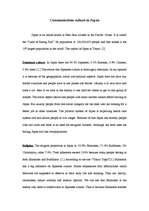-
Communication Culture in Japan
2011–2015 гг.
Masculinity/feminity Japan ranks number 1 on Hofstede’s table [3.8]. As we look earlier on the topic about religion there were things that had an influence on Japanese history in masculinity dominance issue. To be a masculine oriented culture means to have a sympathy for the strong. Also maintenance of economic growth is given highest priority.
Long- and short-term orientation Japan is known as a long-term oriented culture. It means that they are ordering relationships by status and observing this order [3.9.].
High Context/Low Context. According to the table of E. T. Hall’s research Japan is one of the high context cultures[3.3.]. High context cultures have less verbal communication. I think that nonverbal communication like bows show that there is a deeper meaning and for a foreigner it would be impossible to understand. Meaning in high context cultures is also conveyed “through status (age, sex, education, family background, title and affiliations) and through an individual’s informal friends and associates”[3.4.]. This shows how much information they have to carry through their lives. Controlling their behavior and treating people from different statuses. Also taking your shoes off when entering a house shows signs of high context culture. It is a must and nobody will politely ask you to take them off.
…






